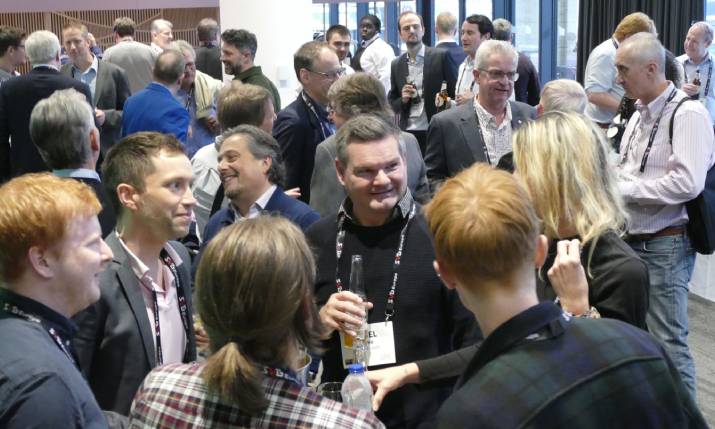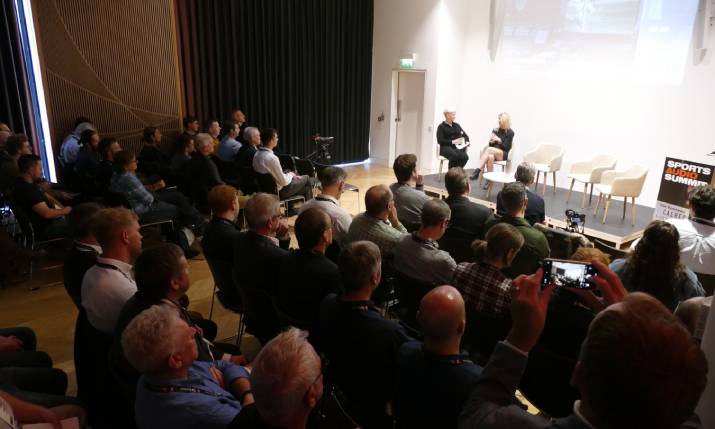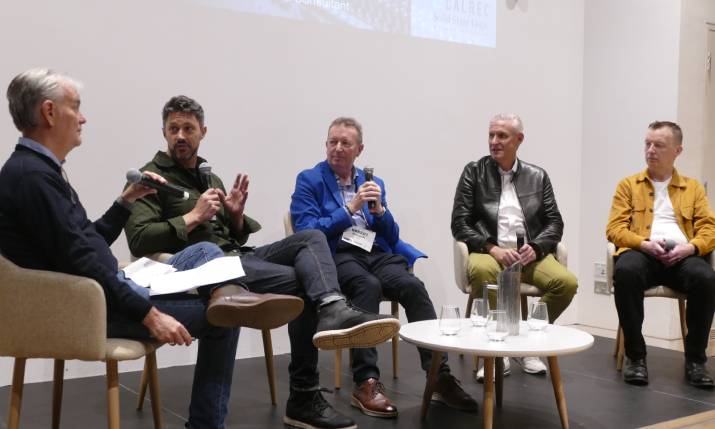SVG Europe Audio: Working out the challenges at Sports Audio Summit 2023

A great turnout for the SVG Europe Audio’s Sports Audio Summit at Kings Place in London on 13 October
Almost 100 attendees packed out the room for SVG Europe Audio’s Sports Audio Summit at Kings Place in London yesterday (12 October). The overriding theme was all about challenges: challenges to the way we already work, challenges to the way we want to work, and incorporating challenging new tools which could help us to get where we want to be.
It quickly became clear that everyone is tackling these challenges in different ways, from how to encourage the creation of immersive audio as a standard and how to deliver it, to different ways to harness the cloud in live sports workflows, how IP is making its mark on audio production infrastructures and whether we can trust artificial intelligence (AI) to help us streamline these same infrastructures, none provide straightforward solutions to broadcasters looking to develop more content and create more engagement. But used in the right way, they are all useful.

At the Sports Audio Summit, Formula 1 audio engineering manager Emma Penny got the event off the starting grid
Formula 1’s Emma Penny
In pole position, Formula 1 audio engineering manager Emma Penny got the event off the starting grid to speak about her journey from studying for an arts degree to managing a team of 13 people (six of them working remotely), as well as a team of contractors, for the biggest motor racing event in the world.
She also spoke about how in these environments, audio coverage is always a challenge. “The action can happen at any point in the race, and because there are cameras at every point we need to ensure we have sound at every point too,” said Penny. “We have around 150 track mics, and positioning those around the track is a full day’s work in itself, and with street circuits where they have live traffic until very shortly before the race, it limits the time we have.
“I am also operational, so am at the races too, and I am very forward facing; I spend time looking at how we can streamline our processes and make things easier for our crews. Although being a woman in audio comes with its own challenges, it not something I get stuck on because I feel I deserve to be in this role. My job is to make audio visible to people above me, and to make sure we have the right crew and enough time.
“You could say that all my jobs and career have been leading to this role.”

Sennheiser’s Renato Pellegrini, Warner Bros. Discovery’s Pete Mercer, sound director Robert Edwards and Dolby’s Rob France joined chair Roger Charlesworth for a discussion on ‘Making immersive audio ubiquitous in live sport’ at the Sports Audio Summit 2023
Making immersive audio ubiquitous in live sport
With adoption growing via music services, more immersive devices on the market, and immersive content readily available on popular streaming services, live sports is up against it; as Sennheiser’s head of Pro Labs and project leader for Ambeo, Renato Pellegrini put it in the next session, “streaming customers expect a certain quality, and sports will be expected to match it.”
But immersive audio carries a broad definition, and joining Pellegrini was an experienced panel including Warner Bros. Discovery’s Pete Mercer, director of live production – sports events, sound director at Video Sound Services, Robert Edwards, and Dolby’s senior product marketing manager, Rob France, who all covered a lot of ground.
Despite the increasing popularity of immersive earbuds and devices, most people are still listening in stereo, and Mercer reminded attendees it is the excitement of the mix which brings the immersion, and not just the format. The panel agreed there is no good reason to add mics to the height channels just to tick the immersive box and context is everything, but widespread adoption is definitely on the way.
Personalisation, where audio objects can be manipulated by viewers to create personal mixes (such as to make the commentary louder, or the crowd quieter) is also a powerful immersive tool, and Edwards spoke of his experience delivering mixes from this year’s Eurovision which were adapted into Serial ADM, bringing us ever closer to that reality.
Until then, there is time to experiment. As session chair Roger Charlesworth summed up, “let’s get immersive behind us so we can get on with personalisation!”
Sports sound in the cloud: What’s next?
Cloud was on the edge of every discussion at this event in 2022, but less than a year later it is no longer in the shadows. Chaired by Professor Felix Krückels, broadcast production and system design at University Darmstadt, everyone on the panel is already using cloud workflows in very different ways, and every implementation is adding value. Moreover, the latency in cloud adoption which everyone worries about is not as challenging as many people think.
Martin Dyster, Telos Alliance VP of business development and Telos Infinity product director, is already working with multiple broadcasters who are using cloud intercoms, while Lama’s Ewan Cameron believes it is entirely dependent on use case: “The acceptability for latency for in ear monitoring is different to other uses. Cloud use needs to be about what the intention is and the appropriate service should be employed for that use case,” said Cameron.
Broadcasters Anthony Sachot, director of audio technology at Warner Bros. Discovery and IMG Studios’ engineering manager, John Munks are both already using cloud workflows, in entirely different ways, and both were relatively fast to get these workflows on air. IMG currently uses AMPP to provide localised commentary to south America from commentators based in Miami and Mexico, while Sachot simply followed the video across a series of POCs.
“We need to just accept that cloud is happening; we are already there. Cloud enables more production at a lower cost,” concluded Sachot.
Uncovering the secret of objective commentary to IS ratio balancing
Creating a break in the panel sessions, Krückels introduced Bachelor student Jonas Engel to discuss how he developed a Reaper plugin which creates objective commentary sound from subjective preferences of different mix engineers.
The plugin, which was derived from Engels’ thesis and automates the volume ratio of commentary and international sound on live sports broadcasts, enables operators to “mix without listening” to free them up to deal with other issues.
Observing the impact of IP on audio production infrastructure
The Summit’s session on IP could have featured every year for the last five years; IP isn’t a new thing. In fact, Lawo’s CTO Phil Myers reminded attendees that Lawo has been working with IP networks for the last 13 years, from Ravenna through to SMPTE 2110. But it was clear that something has definitely changed.
IP is now an enabler for greater efficiency, and remote, distributed and cloud workflows are all possible because of it: “To embrace those workflows you have to make that leap of faith, move I/O to the edge and use IP for backhaul. These days there are fewer standards that everyone has to adhere to and it is no longer a question of when it is going to happen; it already is,” Myers said.
But broadcasters still need to go at their own pace. Like cloud, different organisations have different implementations and Discovery’s Mercer said that while the broadcaster went through the pain of switching to IP some years ago, “it is now very easy to expand on our model; it is very scalable, but each use case must be driven by individual requirements.”
Nevertheless, such a leap of faith takes time and building resilient IP networks is not easy. What Myers playfully described as, “more flamboyant networks” require thorough and constant monitoring to help identify areas of concern; thankfully, monitoring tools are far better than anything we’ve ever had before.
“2110 networks can’t deploy overnight,” warned NEP’s deputy head of sound Neville Hooper. “They require time to plan, build and produce before those infrastructures work at all, and network designers need to ensure they are using the right tools for each application. Planning is paramount.”
Friend or foe? Exploring the potential of AI in sports audio
AI was always going to be the big ticket, and so it proved in the day’s final session. Krückels returned to the stage with Salsa Sound co-founder and CEO Rob Oldfield, and both have extensive experience in utilising AI and machine learning to improve sports output in live environments.
Oldfield explained how data was taken via capture devices in the match play balls during the last World Cup, and were assigned specially designed kick sounds which best matched the context of the play. In this way, he argued, AI can provide richer audio for consumers at home.
In a more practical example, Oldfield described how AI can also enhance speech by turning noise reduction on its head. “If you have data and a need to understand nuanced patterns, AI is your friend,” he said. “For noise reduction and separation, AI is capable of identifying speech patterns and lifting them up rather that reducing the noise, and because AI learns more about the voice in real time it continues to get better at it.”
Krückels predicted AI could help ease the burden on mixers, and he could foresee a time where we “just sit there and QC – the job would become more about sound design where we supervise what the AI does.”
In the meantime, the panel agreed that AI is not a magic box. It takes time to deploy it in a real environment, and it requires a huge amount of data – and a huge amount of time – to train it.
Tech updates
In between sessions were tech updates from Genelec and Audiotonix. First up, Genelec’s regional business development manager Andy Bensley explained how the company’s 9320A Reference Controller provides a single touchpoint for its new UNIO Audio Monitoring Platform. Capitalising on content producers’ focus on immersive formats, Unio acts as a bridge to bring together Genelec Smart Active Monitors, GLM calibration software and Aural ID technology to integrate loudspeaker and headphone monitoring environments.
Meanwhile Audiotonix brands Calrec and SSL teamed up to talk about their “New Heights” Cloud DSP proof-of-concept trials in the US. Directors of production management, Tom Knowles (Solid State Logic) and Henry Goodman (Calrec) revealed how their collaboration provided remote control of audio processing in an AWS cloud for live to air content, and how it is always good practice to have the AWS processing as close to the control location as possible.
Looking ahead to 2024
Despite four panel discussions, two presentations, a case study, and a high-profile keynote interview, there was a lot still to be said. While attendees left with a better understanding of what audio challenges are facing down sports broadcasters, as well as how the audio community is coming together to tackle them, it felt like there are many places that sports audio might go next.
Where those place are and how they develop between now and next year’s meetup is anyone’s guess.

